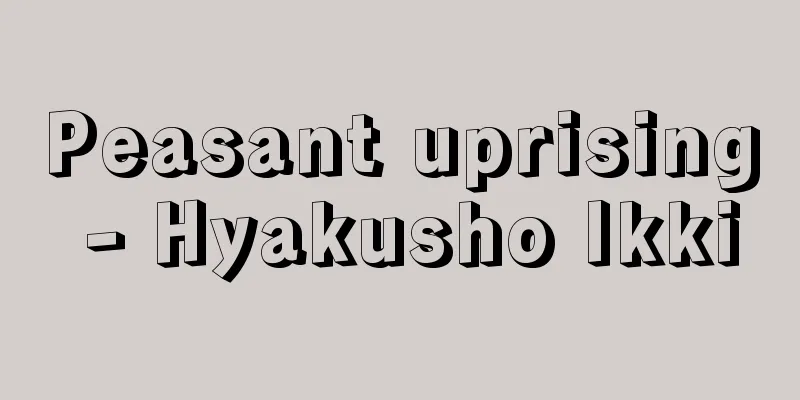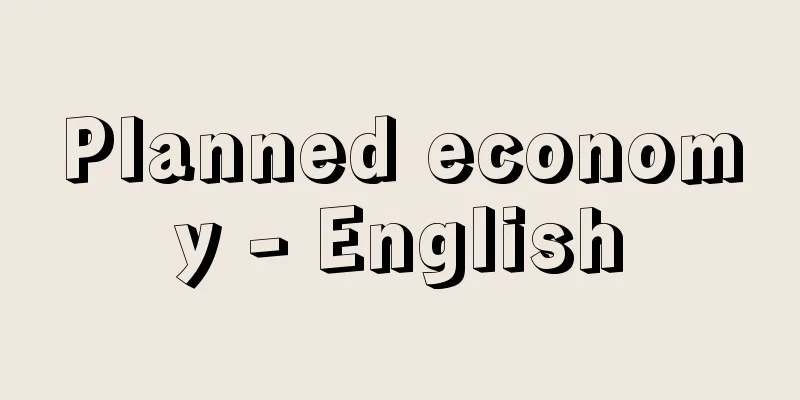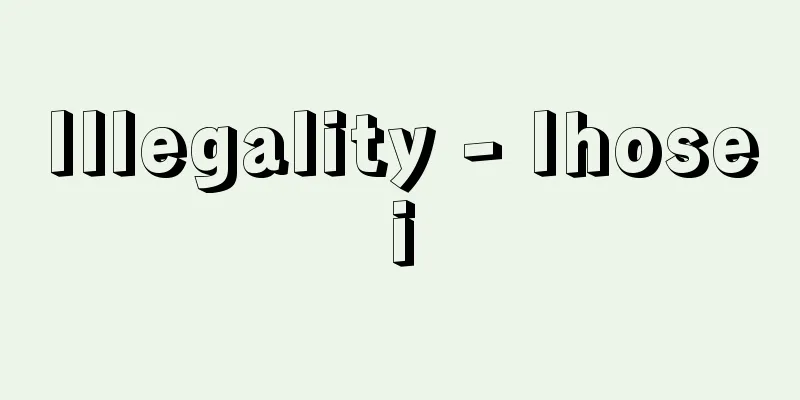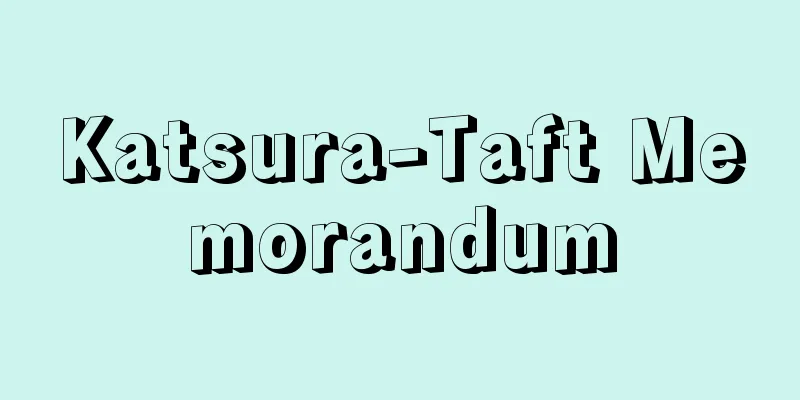Peasant uprising - Hyakusho Ikki

|
In the Edo period, peasants formed gangs and fought against the policies of feudal lords. At the end of the Edo period, there were some social reform uprisings that did not directly target feudal lords, but instead targeted wealthy farmers and merchants, but these are usually considered to be included in the term. According to Aoki Koji's "Comprehensive Chronology of Peasant Uprisings," more than 3,700 such uprisings occurred between 1590 (Tensho 18) and 1877 (Meiji 10). [Satoshi Hosaka] Requirements and FormsThe purpose of the ikkis was to band together and petition through illegal means in order to eliminate the feudal lord's policies that they believed were destroying the lives of the peasants. As the feudal lord's policies were diverse, the demands of the ikkis were also diverse, often consisting of a dozen or even dozens of articles. The contents of the demands included reduction or exemption of taxes and small taxes, improvement of tax payment laws, the borrowing of rice for husbandry and other purposes, exemption from government taxes, the abolition of distribution taxes and the monopoly system, and the removal of government officials. In the early days, the main demand was reduction or exemption of taxes, but from the 18th century onwards, opposition to distribution taxes and the monopoly system and calls for freer distribution of goods became mainstream. The demands of the ikki were not for the reform or abolition of the feudal system, but for the implementation of a "benevolent government" that would allow peasant management to "take root." The logic behind the specific criticism of bad government was that it was a new tax, that it should be returned to the old established law, and that it violated the laws and customs of neighboring territories and the unification of the country. This was also clearly reflected in the actions and appearance of the ikki. With the exception of the early local feudal lords' uprisings, there were no armed conflicts with feudal lords. As weapons, scythes, hoes, and bamboo spears were carried, but these were defensive and generally not used as weapons. Some peasants carried guns, but they were often used as sounds to rally the peasants together, along with bells, drums, and shouts. They were also required to appear in peasant attire, such as straw raincoats and hats. Various forms of struggle were used to make these appeals effective, but they can be broadly divided into four types: osso (a petition to a higher authority), goso (a petition to a higher authority), chosan (a petition to flee), and dasai (a petition to a higher authority). osso means to appeal to a higher authority without going through the prescribed procedures. Typical examples include kagoso (a petition to the palanquin of a feudal lord or a shogunate official), and kakekomiso (a petition to a magistrate's office). Goso is a form of forcing demands through the pressure of a group of people, and in large-scale uprisings, thousands to tens of thousands of people would gather and swarm into castle towns. Refuge refers to the act of leaving one's village in order to see an appeal through, moving collectively to neighboring territories or to mountains or temples where the power of the feudal lord could not reach, and is distinguished from 'running' and 'elopement', which do not involve a petition and do not involve a collective nature. Dakai was an act of breaking into houses in groups and destroying household goods, documents, etc. The purpose was to make it easier for the rebellions to achieve their goals by attacking those who opposed the unification of the peasants, such as village officials who refused to join the villagers' uprisings, and merchants who supported the policies, but gradually they became independent, and there was an increase in uprisings and riots whose main purpose was to destroy wealthy farmers and merchants who were destroying the peasants' businesses. [Satoshi Hosaka] The organization of the rebellion and its presidentIkki were organized not as a gathering of individual peasants, but as a union of villages. Even when they acted together in a strong petition, they acted as a village unit under the village flag, and petitions were often prepared by the final agreement of the village representatives, and were submitted in the form of a "sobyakusho" (a list of peasants for a certain domain or village). Participants in an ikki had a strong sense of unity among the peasants. In order to become one, they often prepared a joint petition for individuals or villages, and it was not uncommon for them to drink sacred water together, accompanied by a pledge. Furthermore, a joint petition called a "kurumarenpan" (umbrella-shaped joint petition) was also used, which symbolized the unity and, secondarily, had the effect of concealing the head of the village. Forcing people to participate, accompanied by threats of burning and destruction, and the destruction of the homes of village officials in villages that did not participate were justified by this sense of unity. Of course, it is not easy to form an alliance of villages. The activities of the village leaders who organize and lead the uprising are essential to the structure of the uprising. The leaders were expected to be executed after the uprising, but they overcame this fear with a spirit of self-sacrifice, urging people to join the uprising, organizing petitions, personally going to petitions, and leading strong petitions. They were not completely free from the village community, but were required to have a wide range of knowledge that could recognize the demands of the peasants in their domain as a whole, rather than being limited to the interests of their own village, and the ability to express them, and they were required to have a strong will. Some of these leaders were passed down as righteous people along with the various clauses won in the uprising, and were deified and commemorated by being enshrined in shrines and having monuments erected. [Satoshi Hosaka] Historical changes in the uprisingsIn the early modern period, local feudal lords opposed new policies such as land surveys and the separation of farmers and soldiers, and their traditional privileges were denied. In these uprisings (domestic feudal lord uprisings), local feudal lords led their subordinate peasants in armed struggle against their feudal lords, mainly in border areas. These types of uprisings occurred frequently during periods of power vacuum or weakness, such as when a new lord took over the domain or the Siege of Osaka, but they were suppressed by the feudal lords who rebuilt their positions, and the last one to come to an end was the Amakusa-Shimabara Rebellion in 1637 (Kan'ei 14). Petitions were also seen in the form of submission of direct guidelines, but most were small-scale, consisting of a single village, and the main parties in petitions were often village officials, with small peasants rarely coming to the forefront of the struggle. One notable example of small peasant behavior during this period was that of the running peasants. This meant that peasants who could no longer bear the tax burden would abandon farming and move to nearby towns or under the control of landlords to work as servants, but because this threatened the feudal lord's control over the countryside, bans were issued frequently and neighbouring domains quickly made arrangements to exchange peasants. In the mid-17th century, as the feudal domain government was further developed and a unified system of exploitation was completed within the domain, ikkis also came to gather in a wide range of villages and confronted this system of exploitation in a comprehensive manner. The form of the struggle was often one or several village officials representing the peasants in the domain filing an appeal, and this was called a representative appeal ikki or an all-domain appeal. As the legend of Sakura Sogoro, who is said to have appealed directly to the shogun, is a typical example, the legend of the righteous people is often passed down as this type of ikki. From the end of the 17th century to the 18th century, the scale of the struggle did not change, but the weight of the strong petition as a form of struggle rapidly increased. This change from the koso to the strong petition reflected the growth of the small peasant class as the main force of struggle, and petitions were carried out with the backing of their activity. This type of uprising is called the so-hyakusho ikki or the all-han strong petition. From around the Kyoho period (1710s-1730s), there were more and more uprisings accompanied by daika (rebellions), and the number of houses that were destroyed increased. They also occurred in large numbers at the same time, with the impact of the struggle increasing, and they were more prevalent in the Shogunate territories, which had previously been relatively rare. As the first daika occurred in Edo in 1733 (Kyoho 18), city dwellers and workers in industries such as salt fields and mines also began to wage their own struggles, which developed in close ties with peasant uprisings. This situation was repeated on a larger scale during the Tenmei period (1780s). In response to these uprisings and the development of various conflicts, the shogunate strengthened its ban on gangs. The bans issued from the end of the Kyoho era through the An'ei and Tenmei periods (1770s-1780s) included stronger regulations for punishing uprisings, permission to send troops across borders to neighboring domains, notices encouraging informants on rebel leaders with rewards for doing so, and permission to use firearms to suppress uprisings. With these shogunate orders as a backdrop, feudal lords who were troubled by uprisings stepped up their oppression. From the latter half of the 18th century, peasants came together across the boundaries of their feudal domains to form regional struggles. This was seen as early as the Tenma-Tousou (horseback march) in 1764 (Meiwa 1), which took place across four provinces along the Nakasendo road, but it was not until the Tenpo period (1830s) that it became widespread. This form of struggle was against the shogunate's national policies, the exploitation associated with the widespread distribution of goods, the monopolization of wealthy farmers and merchants, and the control of usurers. The emphasis on petitions became lighter, and destruction became the main form of struggle. At the same time, national lawsuits (kokuso/kuniso) also emerged in the Kinai region as legal petitions that transcended boundaries. The rise of uprisings during the Tenpo period was due to the simultaneous occurrence of these regional struggles, petitions to all feudal domains, and destruction in cities, and was also accompanied by the Oshio Heihachiro Rebellion in Osaka, which brought a strong sense of crisis to the rulers and led to the Tenpo Reforms. The economic changes that accompanied the opening of the ports at the end of the Edo period had a major impact on the lives of peasants, and semi-professionals who had lost their land protested against the rising price of rice and the plundering of their land, and struggles to destroy wealthy farmers and merchants spread across the country. In particular, in 1866 (Keio 2), during the Bakufu-Choshu War, large-scale uprisings and riots occurred, such as the Edo and Osaka uprisings and the Bushu World Reform Uprising, which marked the highest number of uprisings in the Edo period and had a major impact on the shogunate. In 1868 (Keio 4, Meiji 1), in the political vacuum caused by the Boshin War, uprisings and riots rose again, and the participants in these uprisings came to clearly advocate world reform. When the Meiji Restoration government was established and modernization policies were implemented one after the other, uprisings against these policies broke out all over the country. These uprisings are called anti-land tax reform uprisings or blood tax uprisings depending on the direct cause, but they were not against individual policies, but against the Meiji Restoration government's policies toward the people as a whole, and showed a strong rejection of government officials. The uprisings of this period were also characterized by their violent actions, such as the murder of police officers, armed with bamboo spears and guns. The last peasant uprisings were the Ise Riots of 1875 and the uprisings during the Satsuma Rebellion in Kyushu the following year. Subsequent peasant struggles and popular movements were succeeded by the Freedom and People's Rights Movement and tenant farming disturbances. [Satoshi Hosaka] "A Collection of Peasant Uprisings in the Tokugawa Period, edited by Ono Takeo, volumes 1 and 2 (1927, Tono Shoin)" ▽ "A Study of Peasant Uprisings, by Kuro Masatake (1928 , Iwanami Shoten)" ▽ "The Social Structure of the Meiji Restoration, edited by Horie Eiichi (1955, Ochanomizu Shobo)" ▽ "Social Theory at the End of the Tokugawa Period, by Sasaki Junnosuke (1969, Hanawa Shobo)" ▽ "A Comprehensive Chronology of Peasant Uprisings, by Aoki Koji (1971, Sanichi Shobo)" ▽ "The Tradition of Peasant Uprisings, volumes 1 and 2, by Hayashi Motoi (1971, Shinhyoronsha)" ▽ "The Historical Structure of Peasant Uprisings, by Fukaya Katsumi (1979, Azekura Shobo)" ▽ "Ikki, edited by Aoki Michio et al., all 5 volumes (1981, University of Tokyo Press)" ▽ "The Structure of the Movement for Destroying Rebellions" by Tadao Yamada (1984, Azekura Shobo)" " A Collection of Historical Materials on Peasant Rebellions, edited by Koji Aoki et al., 20 volumes in total (1979-, Sanichi Shobo)" [References] | | | | | | | | | | | |©Shogakukan "> Locations and numbers of peasant uprisings Source: Shogakukan Encyclopedia Nipponica About Encyclopedia Nipponica Information | Legend |
|
江戸時代に百姓を中心として徒党を形成し、領主の政策などに反対した闘争。幕末には直接領主を相手とせず、豪農や商人などに対して打毀(うちこわし)を行う世直し騒動が発生するが、それらを含めて考えるのが普通である。青木虹二(こうじ)著『百姓一揆総合年表』によれば、1590年(天正18)から1877年(明治10)の間に3700余件発生したとされる。 [保坂 智] 要求と形態一揆は、百姓らの生活を破壊すると考える領主の諸政策を排除するために、徒党して非合法的手段で訴願を行うことを目的とした。領主の施策は多様であるから、一揆の要求も多様となり、十数か条から数十か条に及ぶことも多い。その内容は、年貢・小物成(こものなり)の減免、納租法の改善、夫食米(ふじきまい)などの拝借、御用金免除、流通課役・専売制などの廃止、役人の排除などが要求される。初期は年貢減免が主要な要求であったが、18世紀以降しだいに流通課役や専売制に反対し、自由な商品流通を求めるものが主流となってくる。 一揆の要求は、封建制の改廃を求めるものではなく、百姓経営が「成立(なりたち)」うる「仁政(じんせい)」を施行することを求めるものであった。そして悪政を具体的に指摘する論理は、新規課役であること、それを旧来の定法に戻すことと隣領や天下一統の法・慣習に違反していること、にあった。これは一揆の行動やいでたちにも明確に現れている。一揆は、初期の土豪一揆を除き、領主と武力衝突するものは存在しない。得物(えもの)として鎌(かま)や鍬(くわ)などとともに竹槍(たけやり)も持たれたが、防衛的なものであって、武器として使用されることは基本的になかった。鉄砲を持つこともあるが、百姓らが結集するための鳴物(なりもの)として鐘・太鼓・ときの声などとともに使われる例が多い。衣装も蓑笠(みのかさ)などの農民らしい姿で出てくることが求められた。 この訴願を有効たらしめるために多様な闘争形態が駆使されるが、大別すれば越訴(おっそ)、強訴(ごうそ)、逃散(ちょうさん)、打毀の4形態に分けうる。越訴とは、所定の手続を経ずに上級機関に訴願することをいう。領主や幕府役人の駕籠先(かごさき)へ訴状を提出する駕籠訴(かごそ)や、奉行所(ぶぎょうしょ)などへ駆け込む駆込訴(かけこみそ)などが典型である。強訴は、徒党した集団の圧力で要求を強いる形態であり、大規模な一揆では数千から万余の人々が結集し、城下などへ押し寄せた。逃散は、訴願を貫徹するために居村を立ち退き、隣領や領主権力の力の及びにくい山や寺などに集団的に移動する行為をさし、訴願を前提とせず、集団性を伴わない「走り」や「欠落(かけおち)」とは区別される。打毀は、集団で家々に乱入し、家財や書類などを破壊する行為である。その目的とするところは、村人の一揆への参加を拒んだ村役人などの百姓一統の結合に反対する者や、政策に荷担する商人たちを襲うことによって、一揆の目的達成を容易にするものであったが、しだいに独立し、百姓たちの経営を破壊する豪農・商人たちを打毀すことをおもな目的とする一揆・騒動が増えていく。 [保坂 智] 一揆の組織と頭取一揆は個々の百姓の結集ではなく、村々の結合として組織された。強訴で行動をともにする場合も村旗のもとで村単位に行動し、訴状も最終的には村々の代表者の合意によって作成されることが多く、何領何か村惣百姓(そうびゃくしょう)という形式で提出された。一揆参加者には百姓一統という意識が強く存在した。また一統となるために、個人あるいは村々の連判状を作成することも多く、起請文(きしょうもん)を伴い、神水(じんずい)を酌み交わすことも珍しくない。さらに、一統していることを象徴し、副次的には頭取(とうどり)を隠蔽(いんぺい)するための効果をももつ、車連判(くるまれんぱん)(傘状連判(かさじょうれんぱん))という連判形式もとられた。焼討ちや打毀の脅迫を伴う参加強制や不参加村落の村役人宅打毀は、この一統意識によって正当化された。 もちろん村々の連合は容易には形成されない。一揆を組織し指導する頭取たちの活動は一揆構成上不可欠な存在である。頭取は一揆後処刑されることが予想されるが、その恐怖を自己犠牲の精神で乗り越え、人々に一揆参加を説き、訴状を取りまとめ、自ら越訴に赴いたり、強訴の先頭にたった。彼らは村共同体からまったく自由な存在となったわけではないが、居村の利益のみに拘泥(こうでい)せず、領内の百姓全体の要求を認識しうる幅広い知識と、それを表現しうる能力が必要とされ、したたかな精神力の持ち主であることが要求された。この頭取たちの一部は、一揆でかちとられた諸条項とともに義民として伝承され、神格化されて神社に祀(まつ)られたり、碑が建てられるなどの顕彰もなされた。 [保坂 智] 一揆の歴史的変化近世初頭には、検地と兵農分離政策に代表される新政策に反対し、従来の特権を否定された在地土豪が、配下の百姓たちを率い、領主との間で武装闘争を展開する一揆(土豪一揆)が辺境地域を中心に展開した。この形態の一揆は、新領主の入封や大坂の陣などの権力の空白期あるいは弱体期に多発するが、態勢を立て直した領主によって鎮圧され、1637年(寛永14)の天草・島原の乱を最後に終息する。訴願闘争も直目安(じきめやす)の提出という形でみられるが、多くは1村単位の小規模なものであり、訴願の主体も村役人であることが多く、小百姓が闘争の前面に出てくることは少ない。この期の小百姓の行動として注目しうるのは走り百姓である。これは、年貢負担に耐えかねた百姓が、耕作を放棄して周辺の町や地主経営の下に下人(げにん)などとして移り住むものであるが、領主の農村支配を危うくするために、たびたび禁令が出され、隣領との間で走り百姓の交換協約が結ばれた。 17世紀中葉になると、藩政の整備が進み、領域内の統一的収奪体系が完成するので、一揆も広範な村々が結集し、その収奪体系に全面的に対決するに至る。闘争形態は、領内の惣百姓を代表し、1人あるいは数人の村役人が越訴するものが多く、代表越訴一揆あるいは全藩越訴とよばれる。佐倉惣五郎(さくらそうごろう)が将軍に直訴したとされる伝承がその典型であるように、義民伝承はこの型の一揆として伝承されることが多い。 17世紀末から18世紀に至ると、全藩的規模の闘争という点では変わらないが、闘争形態として強訴の比重が急速に増してくる。この越訴から強訴への変化は、小百姓層が闘争主体として成長したことの反映であり、彼らの活動力を背景に訴願の貫徹が図られたのである。この形態の一揆を惣百姓一揆あるいは全藩強訴とよぶ。 享保(きょうほう)期(1710~1730年代)ごろから打毀を伴う一揆が多くなり、打毀される家数が増えてくる。また、同時期に集中的に発生し、闘争の波及性が強まること、従来比較的少なかった幕領に多く起こることなどの特徴を伴ってくる。また1733年(享保18)に江戸で初めての打毀が発生したように、都市民の闘争、塩田や鉱山などの諸産業に働く労働者も独自の闘争を展開し始め、百姓の一揆と密接な関係をもって展開していく。この状況は天明(てんめい)年間(1780年代)により大規模な形で再現される。 このような一揆と諸闘争の展開に対し、幕府は徒党禁令を強化した。享保末から安永(あんえい)・天明期(1770~1780年代)にかけて出される禁令では、一揆処罰規定の強化、隣領への越境出兵の許可、一揆頭取に対する密告奨励とそれに対する褒賞を伴う高札、弾圧への鉄砲使用許可などが盛り込まれ、一揆に悩まされた領主は、この幕令を背景として弾圧を強化していくことになる。 18世紀後半以降、百姓たちが藩領域を越えて結集する広域闘争が成立する。早くは1764年(明和1)の中山道筋(なかせんどうすじ)4か国にわたる伝馬闘争(てんまとうそう)にみられるが、それが一般的となるのは天保(てんぽう)期(1830年代)である。この闘争形態は、幕府の全国政策や広域に展開する商品流通に伴う収奪、豪農・商の買占め、高利貸支配に反対したものであり、訴願の比重が軽くなり打毀が中心的闘争形態となる。同時期には領域を越えた合法的訴願としての国訴(こくそ/くにそ)も畿内(きない)に発生する。天保期の一揆の高揚は、この広域闘争と全藩強訴、都市の打毀が同時的に発生し、大坂での大塩平八郎の乱も加わり、支配者たちに強烈な危機意識をもたらし、天保の改革の要因となった。 幕末の開港に伴う経済変動は百姓生活に大きな影響を与え、土地を喪失した半プロたちが、米価騰貴や収奪に反対し、豪農・商を打毀す闘争が各地に展開した。とくに1866年(慶応2)には、幕長戦争の行われるなかで、江戸・大坂の打毀や武州世直し一揆などの大規模な一揆・打毀が発生し、江戸期最高の一揆発生件数を数え、幕府に多大な影響を与えた。また1868年(慶応4=明治1)には、戊辰戦争(ぼしんせんそう)に伴う政治的空白のなかで再度一揆・打毀が高揚したが、この一揆参加者は、明確に世直しを標榜(ひょうぼう)するに至った。 維新政府が成立し、矢つぎばやに近代化政策を施行すると、それらに対する反対一揆が各地に発生した。それらの一揆は、直接的要因から地租改正反対一揆、血税一揆などとよばれるが、それらの個々の政策に反対したのではなく、維新政府の対民衆政策全体に反対して蜂起(ほうき)し、官に対する強い拒否意識を示した。またこの期の一揆は、竹槍・鉄砲で武装され、邏卒(らそつ)(巡査)を殺害するなど激しい行動を展開するのも特徴である。1875年の伊勢暴動(いせぼうどう)や翌年の九州における西南戦争下の諸一揆が最後の百姓一揆であり、以降の農民闘争・民衆運動は、自由民権運動や小作騒動へと受け継がれる。 [保坂 智] 『小野武夫編『徳川時代百姓一揆叢談』上下(1927・刀江書院)』▽『黒正巌著『百姓一揆の研究』(1928・岩波書店)』▽『堀江英一編『明治維新の社会構造』(1955・御茶の水書房)』▽『佐々木潤之介著『幕末社会論』(1969・塙書房)』▽『青木虹二著『百姓一揆総合年表』(1971・三一書房)』▽『林基著『百姓一揆の伝統』正続(1971・新評論社)』▽『深谷克己著『百姓一揆の歴史的構造』(1979・校倉書房)』▽『青木美智男他編『一揆』全5巻(1981・東京大学出版会)』▽『山田忠雄著『一揆打毀しの運動構造』(1984・校倉書房)』▽『青木虹二他編『編年百姓一揆史料集成』全20巻(1979~ ・三一書房)』 [参照項目] | | | | | | | | | | | |©Shogakukan"> 百姓一揆の発生地と件数 出典 小学館 日本大百科全書(ニッポニカ)日本大百科全書(ニッポニカ)について 情報 | 凡例 |
<<: Baizhang Huaihai - Hyakujo Ekai
>>: Farmers' Network - Hyakushoami
Recommend
Fenestraria aurantiaca (English spelling)
…One of the most unique shapes is the lenticular ...
Phaseolus lunatus (English spelling) Phaseoluslunatus
...The common bean, native to South America, is a...
Ordinary banks and special banks
When national banks existed, ordinary banks were p...
law of effect
...As a result, unsatisfactory responses are less...
Spirit medium - Reibai (English spelling)
A person who is said to mediate between the spiri...
Kopecky, M.
…A Central European republic that existed from 19...
Pellets - Cucumber
→ Spherical Source: Asakura Publishing Dictionary ...
Zoanthachy (Sand Drawstring Bag) - Zoanthachy
A general term for coelenterates (Cnidarians) belo...
Compound explosives - explosives
...The theoretical nitrogen content is 14.14%, bu...
posted price
In the 1950s, the same system was adopted in Saud...
Asclepiad - Asclepiad
…In other words, by publicly declaring that only ...
Yonekichi Inazuka
...The patterns of painted leather changed over t...
Financial Emergency Measures Order
On February 17, 1946, the moratorium legislation w...
Demolition method - Kaitai Kouhou
Every building has its own lifespan. As the materi...
Ryozen Castle
A castle from the Northern and Southern Courts per...









